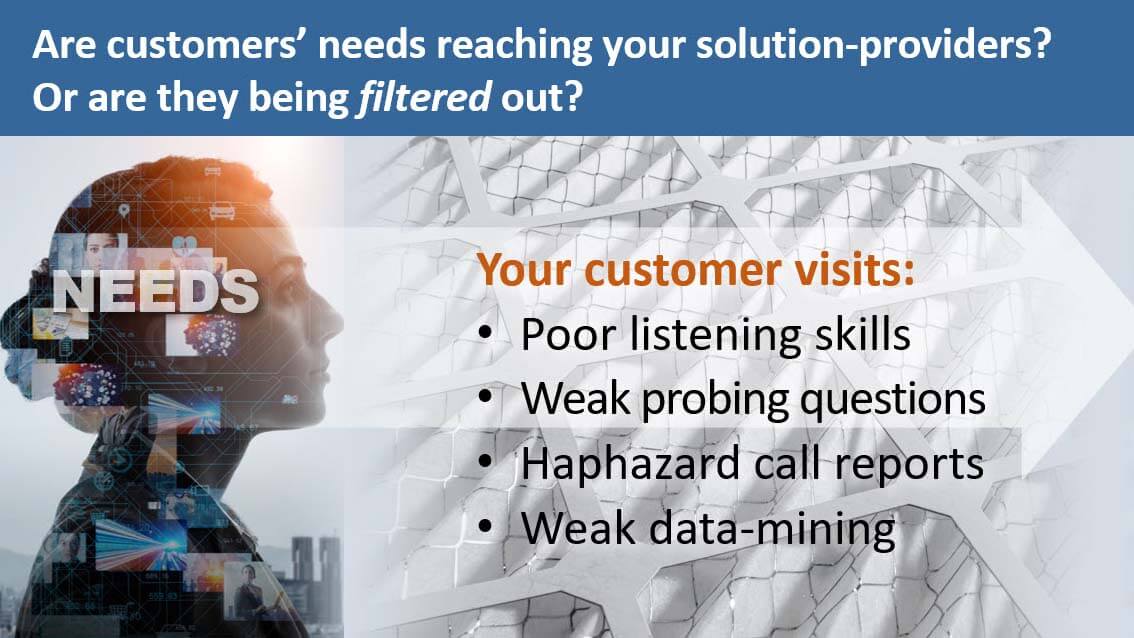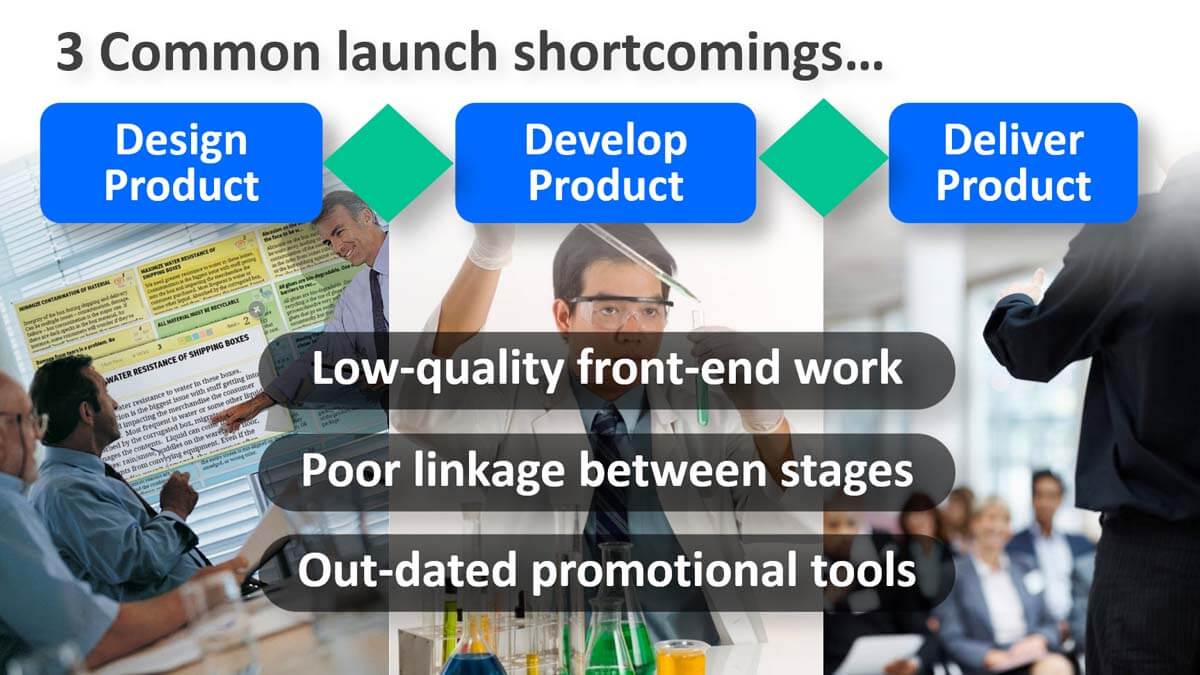Market segmentation is covered in every business curriculum, and for good reason. The best of the best, in every craft, maintain a focus on fundamentals. Consider that the great Tiger Woods continues to perfect his golf swing even as he approaches the end of his career. For innovation, few concepts are as fundamental as market ... Read More
Blog Category: Product Launch
Stop testing B2B market needs by launching products at customers.
Years from now, we’ll think it quite strange that B2B companies explored market needs by launching products to see if anyone would buy them. In the future, B2B companies will have a complete understanding of market needs before they begin developing their products, let alone launch them. Want to start before your competitors?
More in white paper, www.b2btimingiseverything.com (page 5)
What’s ‘filtering out’ customer needs, so that your R&D misses them?
Every one of your B2B customers has needs… problems to be solved. What’s filtering them out, preventing your solution providers from understanding them? 1) Poor listening skills when your employees meet with them? 2) Few probing questions? 3) Haphazard call reports? 4) Weak CRM datamining? You can change all this when your customer-facing employees use Everyday VOC.
More in Everyday VOC white paper, www.EVOCpaper.com
Once your new product is launched, the pricing insight window slams shut.
Customers will help you set prices before—but not after—you launch your new product. They want you to develop innovative new products and services that deliver value to them… so they’ll give you insights to make this happen. These same insights allow you to establish optimal pricing. Do you know how to do this? It will be too late after you launch your product.
More in 2-minute video at 34. Use value calculators to establish pricing
Three B2B product launch problems to avoid.
We see three common shortcomings with B2B product launches: 1) Low-quality front-end work: Suppliers develop the wrong product, so even the best launch is just putting lipstick on a pig. 2) Poor linkage between stages: The launch is not driven by what was learned in the front end. 2) Out-dated promotional tools: This includes poor selection of the many traditional and digital tools available today. It helps to follow these 4 steps: The Right Product delivered to the Right Market using the Right Message through the Right Media.
More in 2-minute video, Launch new products with power
“How’s your new product doing, Joe?”
How do you know if you’re accepting too much commercial risk in your new product development? You know if Joe answers, “Not sure. Guess we’ll find out next month when we launch it.” Future B2B innovators will think this is nuts. When you innovate for a B2B market, nearly everything needed to eliminate commercial risk is “knowable” in the front end of innovation, before development begins. That’s because your B2B customers have high knowledge, objectivity, interest and foresight (as explained in 2-minute video, Understand your B2B advantage.).
More in article, Target Customer Needs and Win
Launch new products with power
You want to deliver the right product to the right market using the right message through the right media. To do this, use AIM’s approach: “Who to tell… What to tell… How to tell.”
b2bgrowth.video/39 Video length [2:40]
What do innovation and marketing have in common?
Peter Drucker said there are only two purposes of business—innovation and marketing—and all other business functions are simply costs. Funny thing is that the unit of innovation and the unit of marketing are the same: customer outcomes. If you don’t understand customer outcomes—their desired end-results—you will neither innovate properly to satisfy those outcomes, nor effectively promote your solutions to them. A clever gentleman, that Mr. Drucker.
More in e-book, Leader’s Guide to B2B Organic Growth
Some leaders could boost innovation by staying home
We see three areas where leaders can have a greater negative impact on innovation than positive: 1) organizational friction (travel bans, spending freezes, hiring delays, excessive re-orgs, etc.) that slow innovation to a crawl, 2) spreading too few resources over too many projects so that nothing moves briskly, and 3) short-changing the front-end of innovation, so that a clear picture of customer needs is lacking. Companies pay a heavy price for keeping such leaders in place.
More in article, Accelerate New Product Innovation
If your new product isn’t easily findable, it could be “game over”
Research shows that it’s often “game over” for your product if a competitor’s product has a better Google search ranking. The key is good search engine optimization (SEO), and the key to that is predicting which keywords your prospects will search for. Here’s a tip: In your front-end voice-of-customer interviews, capture customers’ comments verbatim. Then use their language—which is unlikely to change—in your SEO strategy.
More in article, B2B Product Launch: How to get it right
Your failed product launch was probably doomed earlier
Imagine you just launched your new product and the market responded with… one big collective yawn. Was it a poorly orchestrated launch? Perhaps, but it’s more likely your launch was doomed a couple of years earlier by poor front-end work. Our research shows five of six B2B product development teams lack a clear understanding of market needs before conducting B2B-optimized VOC. Without this insight, your launch might be putting lipstick on a pig.
More in article, B2B Product Launch: How to get it right
Do you permit “factoids” in your product development?
The Oxford Dictionary defines a factoid as an item of unreliable information that is repeated so often it becomes accepted as fact. Too often in product development, what we view as a fact is just a factoid. Its fine to have assumptions, but make sure they don’t dress up as facts. What you think you know is more dangerous than what you know you think.
View video, De-risking Transformational Projects
Launch your products explosively
Most B2B companies are far too “relaxed” about their product launches. Here’s a good roadmap: The Right Product delivered to the Right Market using the Right Message through the Right Media. This especially helps you make market-specific choices from 9 traditional and 9 online promotional media.
More in ebook, 12 New Rules of B2B Product Launch
Your product launch should be as customer-targeted as your product development.
Should your product launch include email… trade shows… pay-per-click? Every market segment tends to favor different venues to learn about new ideas. Rather than guessing—and squandering your budget—you should study customers’ behavior. Don’t think, “How do we communicate?” Instead think, “How do they learn?”
More in article, Stop Squandering Your Product Launch Budget











